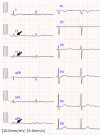Panhypopituitarism Mimicking Acute Coronary Syndrome
- PMID: 35705269
- PMCID: PMC10017242
- DOI: 10.2169/internalmedicine.0031-22
Panhypopituitarism Mimicking Acute Coronary Syndrome
Abstract
A 59-year-old man suspected of having myocardial infarction with sinus bradycardia, a decreased blood pressure, and ST-change on an electrocardiogram was referred to our hospital's emergency department. Emergent coronary angiography revealed no significant findings. However, the patient experienced shock and required intensive care. Curiosity rose when his urination volume was not disturbed; we suspected hormonal abnormalities. A hormonal examination and imaging analysis revealed panhypopituitarism caused by a Rathke's cyst. Appropriate hormonal replacement therapy improved his symptoms and led to normalization of his electrocardiogram findings. Acute coronary syndrome (ACS) is a fatal disease; however, clinicians must not discount panhypopituitarism, as it may mimic ACS symptoms.
Keywords: Rathke's cyst; acute coronary syndrome; panhypopituitarism.
Conflict of interest statement
Figures





References
-
- Chang AM, Fischman DL, Hollander JE. Evaluation of chest pain and acute coronary syndromes. Cardiol Clin 36: 1-12, 2018. - PubMed
-
- McConaghy JR, Oza RS. Outpatient diagnosis of acute chest pain in adults. Am Fam Physician 87: 177-182, 2013. - PubMed
-
- Yamasaki T, Fass R. Noncardiac chest pain: diagnosis and management. Curr Opin Gastroenterol 33: 293-300, 2017. - PubMed
-
- Husebye ES, Pearce SH, Krone NP, Kämpe O. Adrenal insufficiency. Lancet 397: 613-629, 2021. - PubMed

